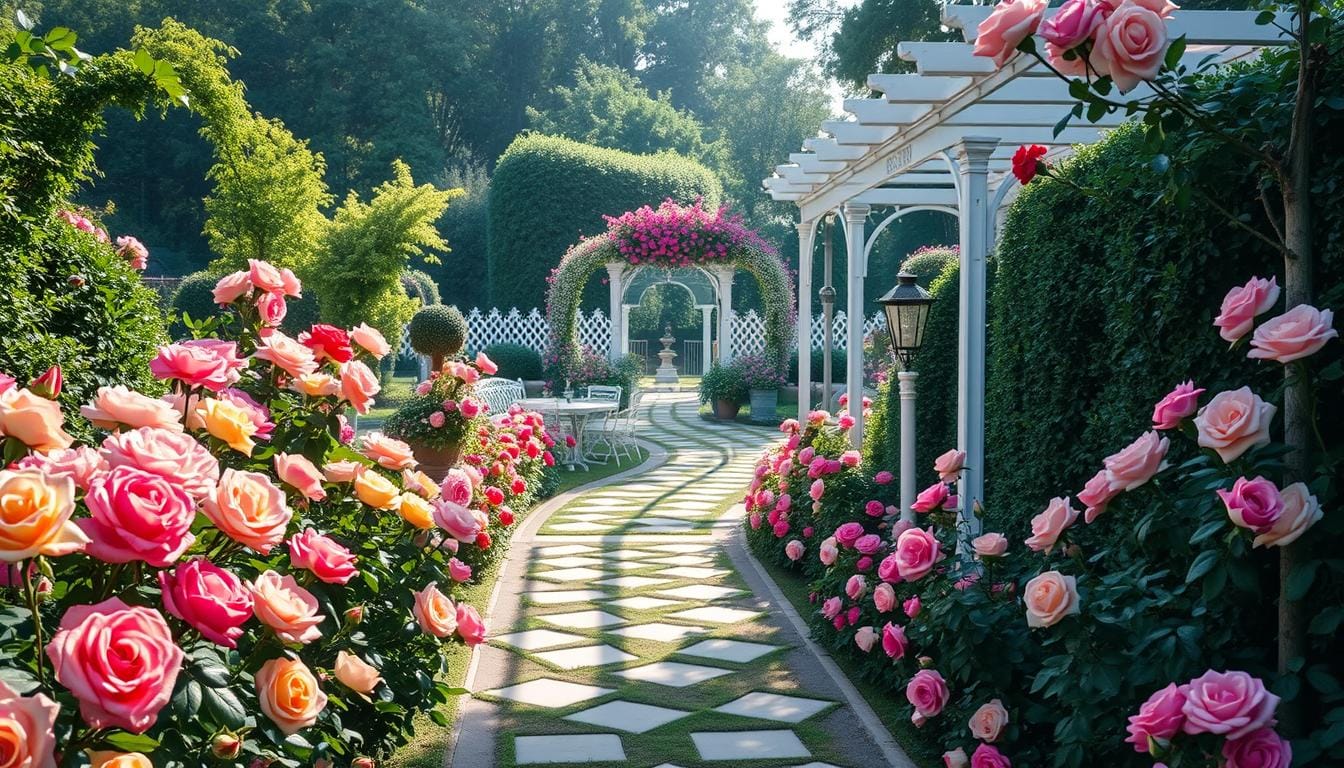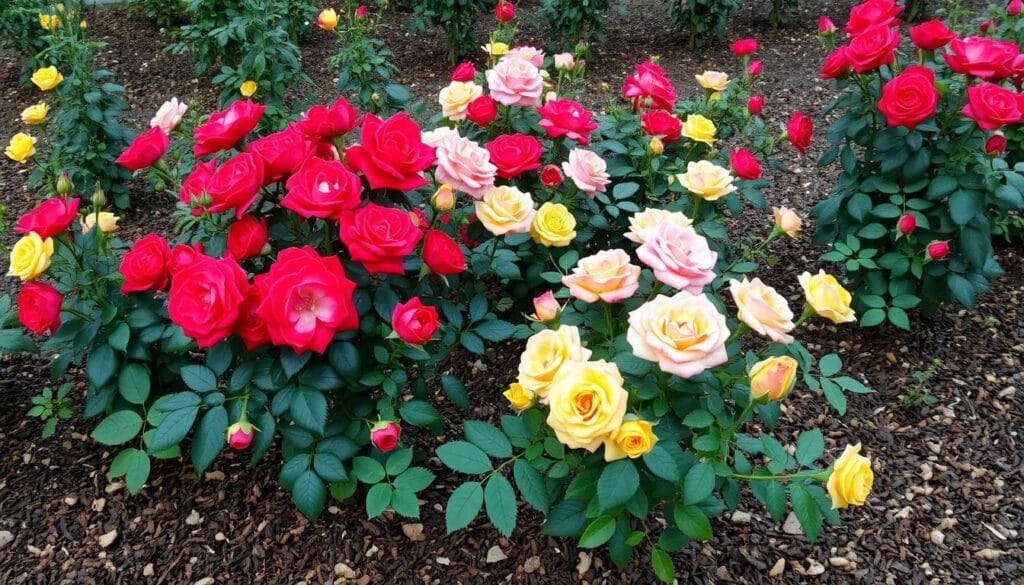Walking into my rose garden, I’m greeted by the beauty of these flowers. They turn an outdoor space into a peaceful oasis. I’m excited to share these beautiful rose garden ideas and tips with you. Roses have bright colors and sweet smells, captivating hearts and inspiring artists for centuries. They can be found in many amazing gardens around the world. Whether you’re looking for ideas or inspiration, we’ve got you covered!
There are many ways to create a stunning rose garden that shows your style. With the right tips, you can make a beautiful outdoor space for relaxation and fun. Designing a rose garden with disease-resistant varieties makes it more sustainable and easier to maintain. Let’s explore the world of rose gardening and see how to create a beautiful and thriving garden. A rose garden’s color palette greatly affects its ambiance, with colors from soft pastels to bold shades.
Key Takeaways
- Hybrid tea roses and floribunda roses are popular choices for rose gardens, offering classic beauty and vibrant colors.
- Designing a harmonious rose garden may involve balancing bold and soft colors, which can enhance visual appeal and create a calming effect.
- Regular maintenance, such as pruning, is essential for promoting healthy growth and abundant blooms in rose gardens.
- Incorporating companion plants, like lavender, can attract pollinators and support local biodiversity.
- A well-planned rose garden layout can involve focal points, like a central rose bush or decorative sculptures, to create an inviting outdoor aesthetic.
- Using monochromatic schemes can enhance sophistication and create a cohesive visual aesthetic in rose gardens.
Understanding the Allure of Rose Gardens
Rose gardens have been loved for centuries. Their beauty comes from a long history of rose gardening. For beginners, knowing the best roses and how to grow them is key. With the right tips, anyone can make a beautiful rose garden.
Roses have always been a symbol of love. Today, they add beauty and scent to outdoor spaces. When picking roses, consider types like hybrid tea and floribunda. They do well in well-drained, rich soils and temperate climates.
For new gardeners, a beginner’s guide is crucial. It covers the basics of rose care, like soil, water, and pruning. By following these tips and choosing the right roses, you can have a stunning garden. Compact roses, like miniatures and patio roses, are great for small spaces.
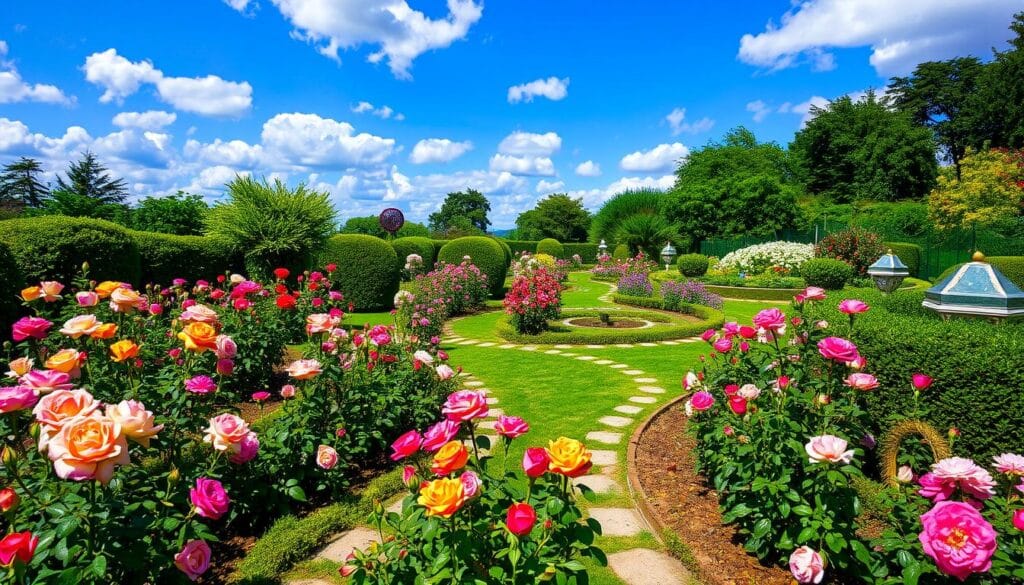
Roses are not just beautiful; they also attract pollinators and fill the air with scent. With proper care, they can grow in many conditions. Whether you’re experienced or new, a rose gardening guide can help you create a lovely garden.
Choosing the Right Location for Your Rose Garden
Creating a beautiful rose garden starts with the right location. Your roses need sunlight, well-drained soil, and enough space to grow. Here are some tips for a stunning rose garden, including DIY projects.
Roses love full sun, needing at least six hours of direct sunlight daily. This is key for their growth and blooms. Even with partial sun, roses can grow, but they might not bloom as much. Choose a spot that gets direct morning sunlight to avoid powdery mildew.
Soil type and drainage are also important. Roses prefer soil with a pH between 6.0 and 6.5. If your soil is heavy clay or sandy, you might need to adjust it. Make sure there’s enough air around your roses to prevent disease.
Consider the garden’s size, soil type, and maintenance needs. A 20 ft. by 20 ft. area is great for low maintenance. Use existing trees to save space and enhance your garden’s design. By following these tips, you can create a beautiful and thriving rose garden.
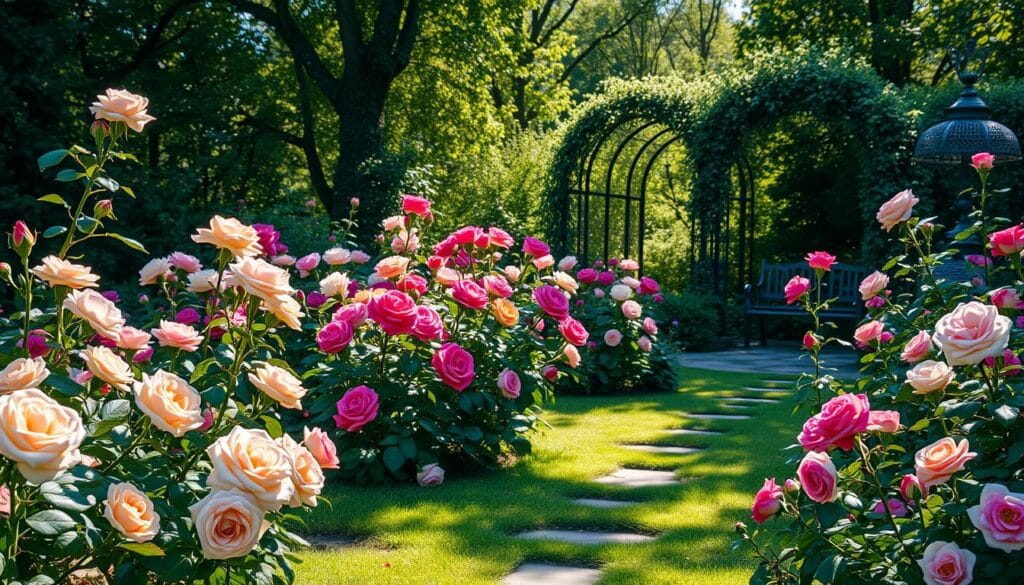
Essential Tools and Materials for Rose Gardens
To keep your rose garden looking its best, you’ll need the right tools and materials. Having the right tools can make a big difference in rose garden maintenance. Good gardening tools help reduce frustration when trimming and weeding. Personal pruning tools, like Felco secateurs, are known for their durability and comfort, but they are an investment.
For a rose garden, you’ll need pruning tools, soil amendments, and pest control products. Bypass blades are better for pruning roses because they make clean cuts without damaging canes. This is important for the health and vigor of rose plants. Also, a folding pruning saw is key for reaching thick canes that regular tools can’t get to, showing the importance of diverse garden tools.
Some other essential tools and materials for rose gardens include:
- Soil amendments, such as compost or fertilizer, to promote healthy soil and plant growth
- Pest control products, such as insecticidal soap or neem oil, to prevent and control pests and diseases
- A watering can or hose with a spray nozzle, to provide adequate water and moisture to the plants
With these essential tools and materials, you’ll be ready to maintain a healthy and thriving rose garden. You’ll enjoy the beauty and fragrance of these lovely flowers. Plus, growing your own plants is rewarding and helps with pest control for roses.
Designing a Rose Garden Layout
Designing a rose garden layout involves many choices. You must decide between a formal or informal design. Formal designs have straight lines and symmetrical patterns. Informal designs are more relaxed, with curved lines and varied plants.
To create a stunning rose garden, mix different elements. Use formal hedges with informal pathways. Adding plants like lady’s mantle and larkspur can bring color and texture.
Some great rose garden ideas include:
* A central focal point, like a statue or fountain, to draw the eye
* Curved pathways and informal plantings for movement and energy
* A mix of textures and colors for depth and interest
* Using different rose types, like climbing or shrub roses, for variety
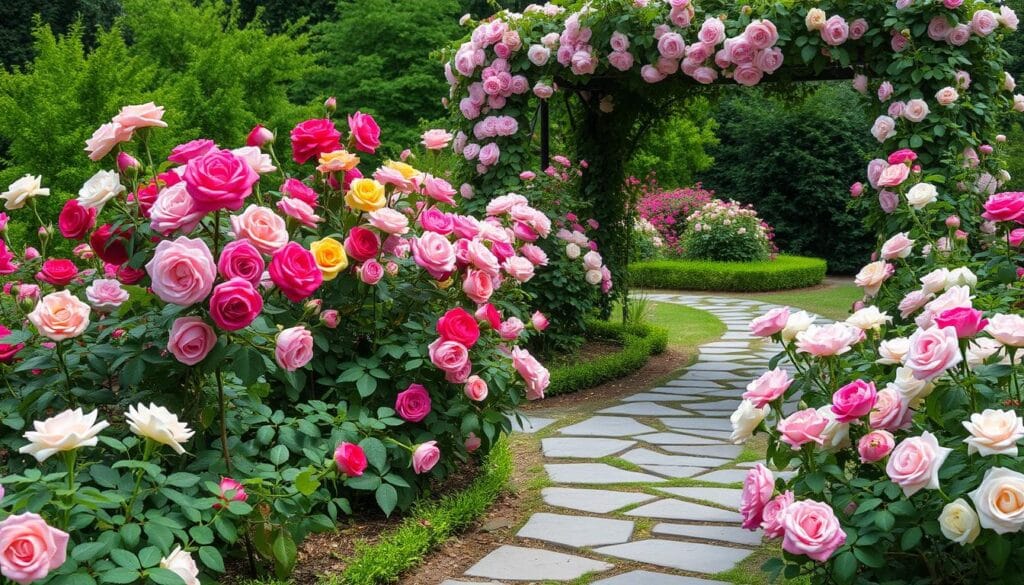
By thinking about these factors and using various design elements, you can make a beautiful rose garden. It will show your style and enhance your outdoor space. With planning and creativity, your rose garden will be stunning for years.
Selecting the Perfect Rose Varieties
Choosing the right roses for your garden can be tough. There are many types of roses out there. The Rosaceae family has 150 species and thousands of cultivars, giving gardeners lots of options.
Popular roses include hybrid teas, floribundas, climbing roses, and shrub roses. Hybrid teas, introduced in 1867, have large, repeat-blooming flowers. Floribundas produce clusters of blooms. Climbing roses can grow up to 12 feet tall, great for trellises or arbors. Shrub roses are easy to care for and can grow in many conditions.
When picking roses, think about sunlight, soil, and bloom color. The right mix of roses can make your garden beautiful and full of life.
| Rose Variety | Description | Characteristics |
|---|---|---|
| Hybrid Teas | Large, repeat-blooming flowers | Tall, upright growth habit |
| Floribundas | Clusters of blooms | Compact, bushy growth habit |
| Climbing Roses | Long, trailing stems | Large, fragrant blooms |
| Shrub Roses | Low-maintenance, disease-resistant | Compact, rounded growth habit |

Seasonal Considerations for Rose Gardening
Rose gardening is a journey through the seasons. It’s key to care for our roses properly. With over 150 types of roses, knowing their needs is crucial. Roses bloom from late May to early fall, lasting about 4 months.
Summer is a critical time for rose garden maintenance. July, August, and September are key months for care. Water roses in the cool morning or evening to avoid scorching. Fertilizing in summer keeps blooms coming; use water-soluble or slow-release fertilizers.
Preparing for winter is vital. Protect roses from harsh weather and give them the care they need. With the right care, your rose garden will thrive all year.
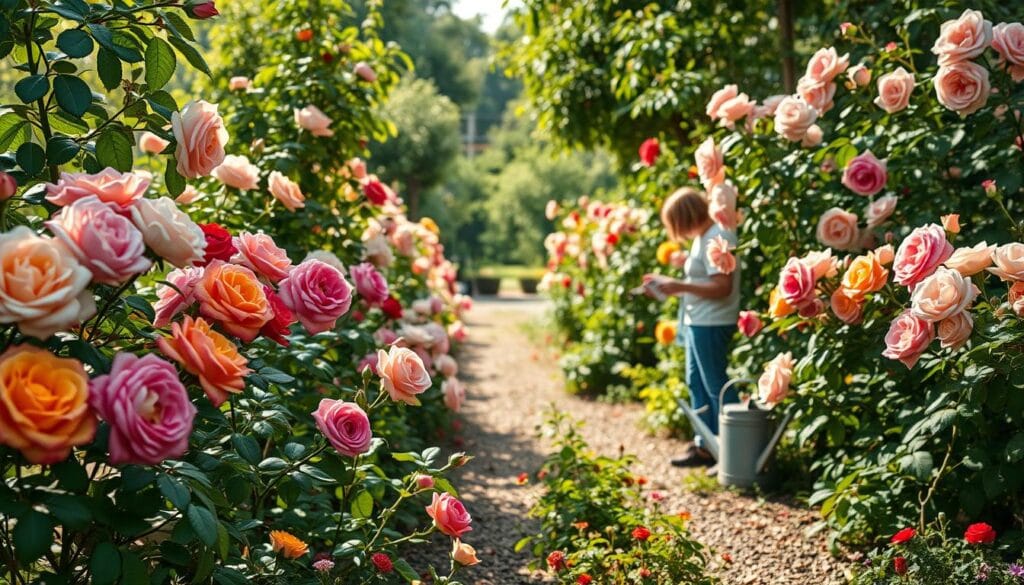
- Plant roses in the spring or fall, when the weather is cooler
- Water roses regularly, but avoid overwatering
- Fertilize roses monthly, using a balanced granular fertilizer
- Prune roses in the late winter or early spring, to promote healthy growth
By following these tips, you can have a stunning rose garden. It will add joy and beauty to your outdoor space.
Incorporating Companion Plants with Roses
When you design a rose garden, picking the right companion plants is key. These plants help make your garden look better and stay healthy. A balanced garden is essential, and the right plants can make it happen. They also attract good bugs and keep pests away.
Lavender, marigolds, and bee balm are great choices for roses. They like the same sun and soil as roses. Plus, they keep pests like aphids and Japanese beetles away.
Here are some perks of adding companion plants to your rose garden:
- Improved pollination rates
- Increased biodiversity
- Pest control and repellent properties
- Enhanced garden beauty and fragrance
By adding companion plants, you make your rose garden better and more useful. Pick plants that grow well together and fit your local weather. With the right mix, your garden will be full of life and keep pests away.
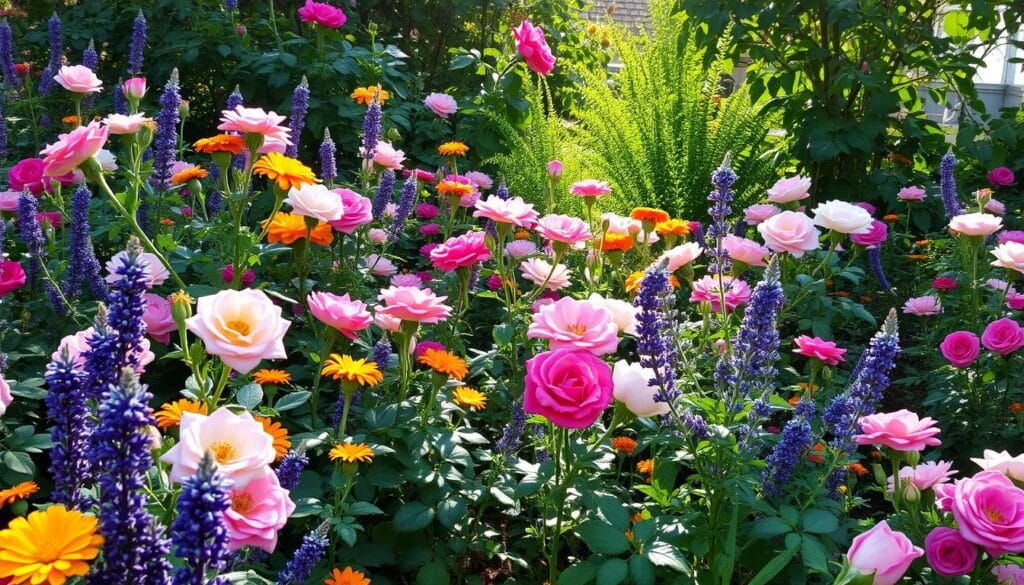
Color Themes for Rose Gardens
Creating a beautiful rose garden starts with choosing the right color theme. A well-thought-out color scheme adds beauty and interest to your garden. Seasonal color changes make your garden dynamic and captivating. You can pick from monochromatic, complementary, or contrasting colors for your garden.
A monochromatic scheme uses different shades of one color, creating a soothing atmosphere. Complementary colors, on the other hand, are opposite each other on the color wheel, making your garden vibrant. Mixing warm and cool colors can also make your garden inviting and balanced.
Think about the seasonal color changes when planning your garden. Planting roses that bloom in different seasons adds color throughout the year. By choosing the right colors and considering seasonal changes, your rose garden will be stunning for years.
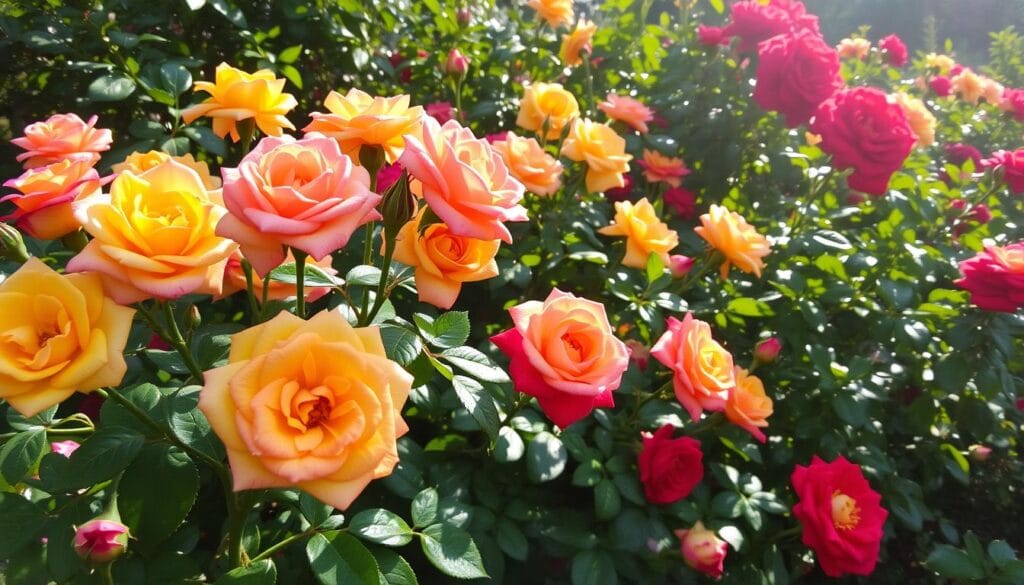
Maintenance and Care for a Thriving Rose Garden
To keep your rose garden looking its best, focus on maintenance. This includes proper watering and fertilization. With the right care, you’ll enjoy beautiful blooms and a healthy garden. Roses do better with one big watering a week, not small amounts every day.
For fertilizing, use a mix with more phosphorus than nitrogen or potassium. This helps with root growth and blooms. Make sure the soil pH is slightly acidic to neutral, between 6.0 to 7.0. This ensures nutrients are available. By following these steps and using the right fertilizers, your rose garden will bloom beautifully and thrive.
Some key tips for rose garden maintenance include:
* Watering roses deeply once or twice a week, depending on weather conditions
* Fertilizing roses regularly, using a balanced fertilizer
* Pruning roses in early spring, removing dead or damaged growth
By following these tips and using the right techniques, you can keep your rose garden looking its best. Enjoy beautiful blooms all season long.

| Task | Frequency |
|---|---|
| Watering | 1-2 times a week |
| Fertilizing | Regularly |
| Pruning | Early spring |
With proper rose garden maintenance, including watering techniques and fertilization schedules, you can create a beautiful and thriving garden. It will bring joy and beauty to your outdoor space.
Dealing with Common Rose Pests and Diseases
As a rose gardener, I’ve learned that dealing with common rose pests and diseases is crucial. These can cause significant damage to your plants. It’s essential to identify them early and take action.
Some common pests include aphids, rose chafers, and Japanese beetles. Organic control methods can help control these pests. These methods prevent infestations and infections, reducing the need for pesticides.
Preventative measures are also key. Regular pruning and sanitizing tools help prevent disease spread. Black spot, botrytis blight, and crown gall are common diseases. Good air circulation, removing infected tissue, and avoiding excessive watering can prevent them.
Introducing beneficial insects, like ladybugs and lacewings, can control aphids. Neem oil and insecticidal soap also control various pests. By combining these methods with preventative measures, you can keep your garden healthy and thriving.
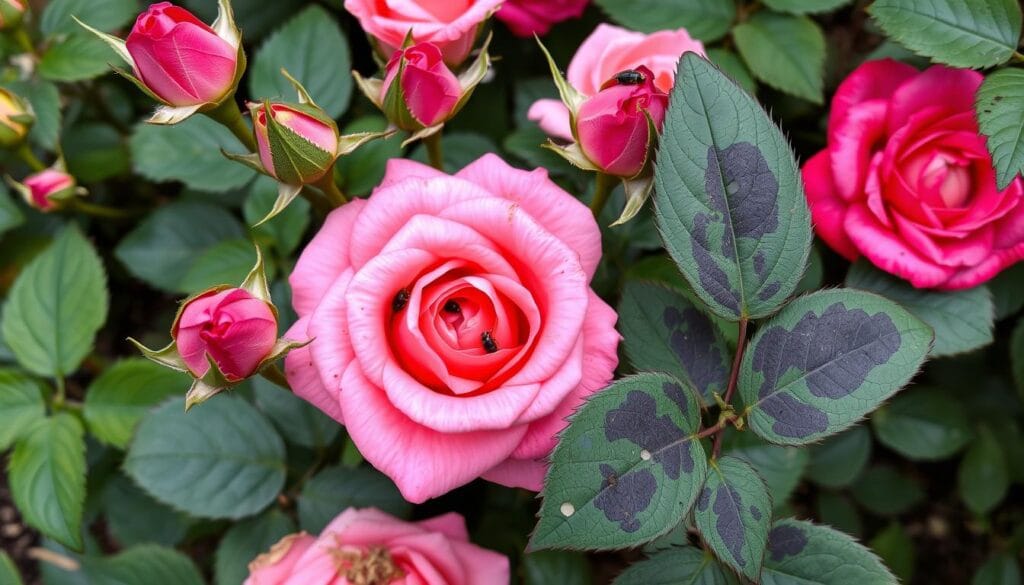
Creating a Relaxation Space in Your Rose Garden
A well-designed rose garden can be a perfect spot to unwind. To make it special, add seating areas, water features, and lighting. A backyard of about 3,000 square feet can be turned into a serene oasis. Allocate about 800 square feet for a flower bed area and add seating and water features.
Think about the seating you can include, like benches, chairs, or hammocks. Water features like small ponds or fountains can also add to the calm. White lights along the fence can make your garden beautiful day and night. Choose plants like roses, lavender, and catmint for a peaceful environment.
Popular roses for a relaxation space include ‘Roald Dahl’ and ‘Zéphirine Drouhin’. These roses are fragrant and beautiful. Combine them with other plants and features for a sensory experience. Here are some tips:
- Choose plants that are easy to maintain and require minimal care.
- Incorporate a water feature, like a small pond or fountain, to create a soothing atmosphere.
- Use lighting to create a warm and inviting ambiance in the evening.
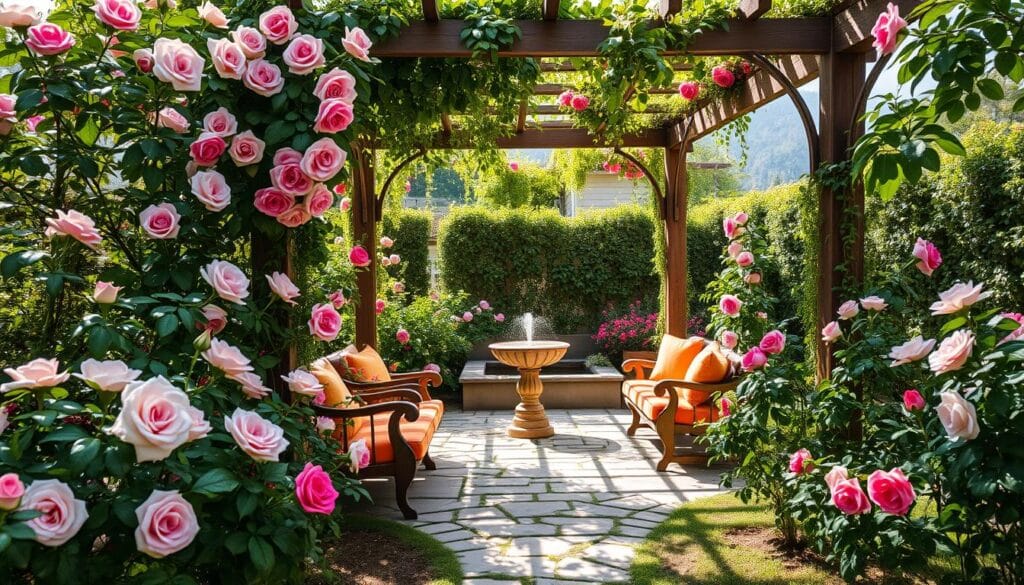
By following these tips and incorporating the right features, you can create a beautiful and peaceful rose garden. Enjoy it for years to come.
| Feature | Description |
|---|---|
| Seating Areas | Benches, chairs, or hammocks to create a comfortable spot to relax. |
| Water Features | Small ponds, fountains, or birdbaths to create a soothing atmosphere. |
| Lighting | String lights or lanterns to create a warm and inviting ambiance in the evening. |
Using Containers for Roses
Container gardening is perfect for growing roses in small spaces or on balconies. It’s important to pick the right containers for your roses. Consider the size and material. Miniature roses, polyanthas, minifloras, and small shrub roses work well in containers.
Roses in containers need at least six hours of sunlight a day. They also need regular watering, more so in summer. Use a mix of two-thirds potting mix and one-third compost for the soil. Make sure to space them 2 to 3 feet apart for good air flow.
For seasonal planting, use self-watering pots and fertilize with slow-release organic rose food in spring. With the right care, container roses can bloom beautifully all season. Follow these tips and choose the right containers for a stunning container garden.
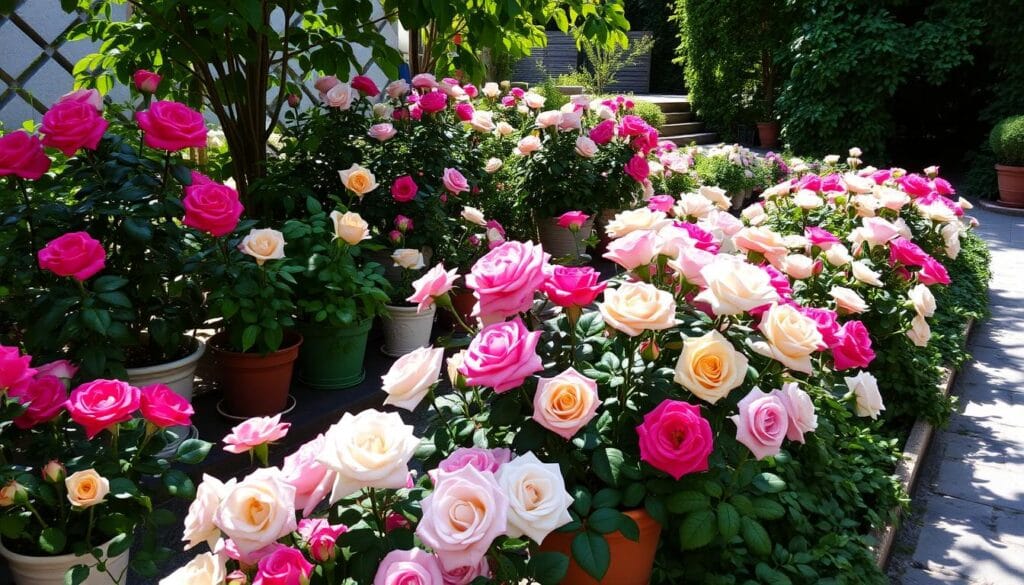
Popular roses for containers include Easy Elegance® Roses. They are disease-resistant and bloom long. With proper care, these roses will add elegance to your garden all season.
The Role of Mulching in Rose Care
Mulching is key for rose care. It keeps the soil moist, stops weeds, and controls soil temperature. There are many mulch types to pick from, each with its own benefits. You can choose from organic mulches like grass clippings, straw, and shredded wood. Or go for inorganic mulches like gravel and shredded cedar.
Mulching has many advantages for your rose garden. It helps keep the soil moist, so you don’t have to water as often. This is great during hot summers. Mulch also fights weeds, which take water and nutrients from your roses. To use mulch well, pick the right type for your climate and soil. And apply it the right amount.
Here are some tips for mulching:
- Choose a mulch that fits your rose type and climate
- Put a 2-3 inch layer of mulch around your roses, but not touching the plant base
- Keep adding mulch to keep the depth right and stop weeds
Sustainable Practices in Rose Gardening
We gardeners must protect the environment and use sustainable practices. Sustainable rose gardening means using organic methods, saving water, and helping pollinators. This way, we reduce our gardening’s environmental impact and make a healthy ecosystem.
Using organic landscaping is a key part of sustainable rose gardening. We use natural soil helpers like compost and avoid harmful chemicals. Organic methods improve soil, prevent erosion, and support many species. It’s also important to save water with smart irrigation and rainwater collection.
Helping pollinators is vital in sustainable rose gardening. We do this by planting flowers that attract bees and butterflies. A garden that welcomes pollinators supports our local ecosystem and keeps our roses healthy.
Some great sustainable rose types include Baby Love, Bonica, and Knock Out. These roses are tough against diseases and need little care. By picking these varieties and using organic gardening, we can have a stunning, eco-friendly rose garden.
| Sustainable Rose Variety | Disease Resistance | Maintenance Requirements |
|---|---|---|
| Baby Love | High | Low |
| Bonica | Medium | Medium |
| Knock Out | High | Low |
Inspiring Rose Garden Examples
As we wrap up our journey into the world of rose gardening, let’s look at some inspiring examples. Roses come in many forms, like climbers and bushes, showing their flexibility in garden design.
First, we have public rose gardens like the Butchart Gardens in Canada. Here, over 55,000 roses bloom in a beautiful, formal layout. Then, there’s the David Austin Rose Garden in England, known for its stunning mix of heritage and modern roses.
Home gardens can also be transformed into something amazing. People have turned their yards into fragrant, lush spaces. They use climbing roses over arches, shrub roses with perennials, and creative container plantings.
Lastly, we see rose gardens that break the mold of traditional landscaping. Roses can cover garden walls, trail along structures, or even be part of living sculptures. This shows the artistic side of these flowers.
We hope these examples inspire you to create your own rose garden. It could be a classic design or a unique, whimsical space. Get ready to let your creativity shine and make your outdoor area beautiful with roses.
FAQ
What are the key considerations when choosing the right location for a rose garden?
When picking a spot for your rose garden, think about sunlight, soil, and where other plants are. Roses need lots of sunlight, about 6 hours a day. They also need soil that drains well and should be far from plants that might compete for water and nutrients.
What are some essential tools and materials needed for maintaining a rose garden?
For a rose garden, you’ll need pruning shears, loppers, gloves, a hose, compost or fertilizer, and pest control. Having the right tools makes it easier to care for your roses. This includes pruning, fertilizing, and keeping pests away.
How can I design a beautiful and functional rose garden layout?
Designing your rose garden can be formal or informal. Use pathways, borders, and focal points to organize and add beauty. Think about the look you want and balance different elements for a stunning garden.
What are some of the best rose varieties to grow in a home garden?
For a home garden, consider hybrid teas, floribundas, climbing roses, and shrub roses. Each type has its own look, growth, and care needs. Choose the right ones for your garden.
How can I care for my roses throughout the different seasons?
Rose care changes with the seasons. In spring, plant, prune, and fertilize. Summer means watering, deadheading, and watching for pests. Fall is for pruning and mulching. Winter needs protection from cold.
What companion plants work well with roses in the garden?
Roses do well with plants that add color, texture, or function. Lavender, catmint, marigolds, and annuals are great choices. These plants also help attract beneficial insects.
How can I make my rose garden more sustainable and eco-friendly?
To green up your rose garden, use organic methods, save water, and attract pollinators. This includes natural pest control, mulching, and planting for pollinators.
